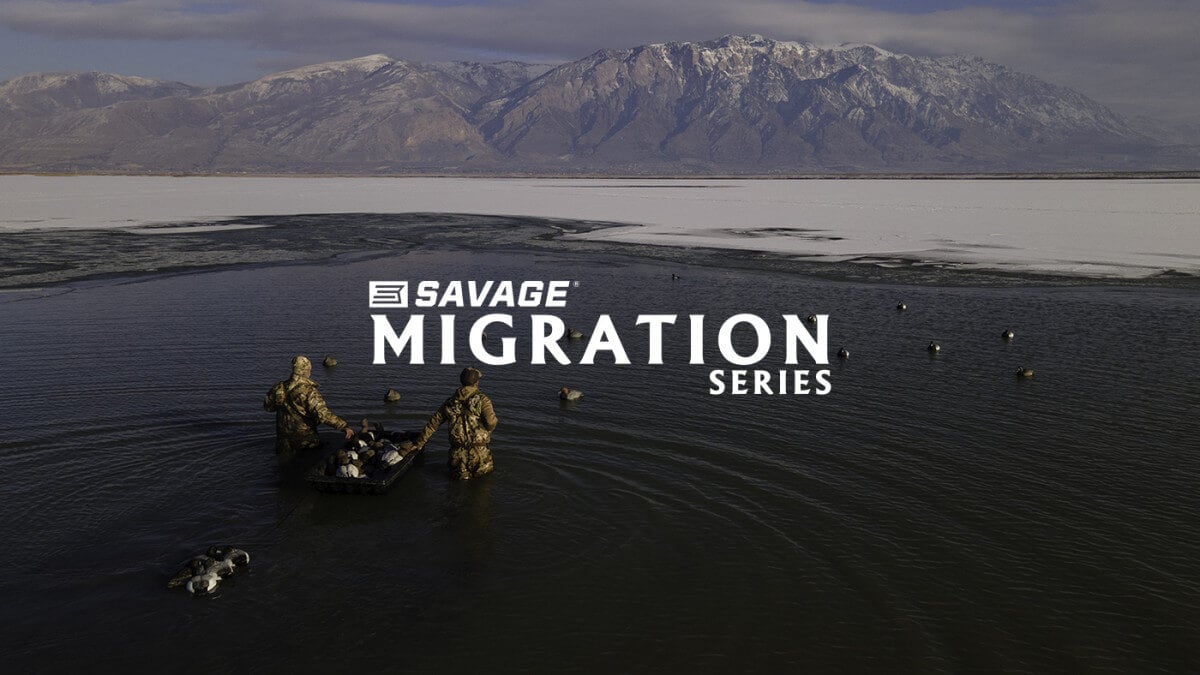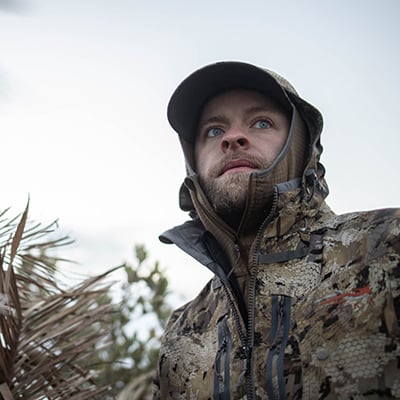- Savage Blog
- Migration Series: Frozen Marsh | Utah
Migration Series: Frozen Marsh | Utah

The current time is 4:23am: Tony and I set off into the dark, sleds full of decoys dragging behind us. With every step the ice talks to us shooting spurs of cracks as far as you can see. We joke, “This goes against everything I’ve ever learned about ice safety”. Hunting the late season migration on the ice in northern Utah is an adventure every waterfowler needs to experience. Our target destination is a pocket of open water we had located the day before during our hours-long scouting mission.

As we get closer to our target hole-in-the-ice the silence explodes with hundreds of birds making an evacuation. Thankfully the birds stayed all night, keeping the water moving and the ice at bay… at least for now. The goal for the morning is to get an enticing decoy spread put out while the birds are bouncing off the lake. When they return to feed, we will be waiting.

With about ten minutes remaining until legal light, the birds began diving into the hole like fighter jets on a strafe. As we tick closer and closer to shooting time the sun begins to crest over the mountain tops exposing an Arctic like landscape.

It’s hard to imagine the birds thrive in this environment, following the weather from Canada all the way to our southern border and beyond during their annual migration. On warm weather years when the ice is nowhere to be found, the birds are scattered throughout the marsh, but this year is cold—really cold. The marsh is almost completely frozen with the exception of the few pockets kept open from feeding ducks, geese, and swans. The holes in the ice allow for the congregation and exceptional hunting of the birds that have been too stubborn to head south. It’s a preferred time of year for the hunters willing to battle the cold and the extreme weather.
Legal shooting time is upon us, and the sky is packed with flock after flock of birds looking for a place to feed. It didn’t take more than a minute and we had a pair committed. Buffleheads, “drake on the right!!” I shoulder the Renegauge and take my shot, the bird folds into the frigid waters below. Not a minute later the crimson bomber that is the canvasback comes screaming across the deck looking for somewhere to touchdown. To my left Tony sits up, takes aim, and cancels the flight.

Tony and I have been hunting together for six seasons now. When I first started to take waterfowl hunting seriously, I reached out to him to ask a few questions. With his 30+ years hunting the Utah marsh, I figured he would have an answer to any question I could drum up. We have been chasing birds together ever since.
With two quick birds down, we thought it would only take a few minutes to get our limit, but the birds had a different idea. We sat for about 30 minutes watching birds by the dozens land into a different hole about 300 yards away from us. We made a collaborative decision to pack up and move to that hole. With a new strategy and the decoys reset, the hunt resumed.
Gadwall, gadwall, and more gadwall in and out of the decoys all morning. We had held off taking gadwall because of our desire to target canvasbacks, which we had seen scouting. Eventually a hunter’s patience comes to an end, and it was time to make the gadwall pay rent for the taunting they had been doing. It didn’t take long before we had just a few birds shy of our two-man limit.

As most duck blinds go, we joked with each other and told stories of seasons past all the while being surprised by bird after bird sneaking in on us, not to worry though we were having too good of a time to care. Eventually, we buckled down long enough to finish the limit.
Day Two brought an extreme shift in weather and very stagnant birds. We endured sideways snow, blinding fog, and frigid winds. The thick fog prevented the birds from seeing our decoys unless they flew right into us. We managed to knock a few down but nothing in comparison to the fast action of the day before. It serves as a humble reminder that ultimately, despite your best efforts, sometimes it’s just not your day. I joked about how completely different my upcoming Texas trip was going to be. We told more stories of hunts past and spent the remainder of the day just enjoying what Utah had to offer despite the lack of cooperation from the birds.
Being born and raised in Utah, I almost feel guilty for how much I take the waterfowl hunting for granted. We experience a massive migration right through the heart of our state bringing in dozens of different species of birds visiting the Bear River Bird Refuge, The Great Salt Lake and its surrounding marshes. It’s not uncommon for the average hunter to harvest twenty or more different species of birds in any given season. It truly is a hidden gem. Whether it be a corn field for big Canadian geese, a layout boat for divers, or one of my personal favorites hunting the skinny water for mallards and pintails, we have it all.

It’s comforting knowing that regardless of the hunting conditions, my Renegauge will perform as expected. With its well-balanced design and customizable fitment, I’ll be ready to shoot the trophy bird of a lifetime. An opportunity that was presented just days later when I traveled to Bay Flats Lodge in Seadrift, Texas with a few of my fellow Savage Arms Ambassadors. I have been pursuing the North American Waterfowl Slam, which is harvesting 41 different species in North America. I am currently sitting at 31, and a beautiful south Texas Redhead would give me another species and get me closer to my goal.
Day One in Texas and there were more redheads than I could begin to describe. The sky was literally bursting with birds. And it didn’t take long until a trophy drake gave me a shot opportunity. With the pull of the trigger that puts me at 32 species. We are now into single digits left on my slam.
Seeing such completely different environments from Utah to Texas just days apart proves just how hardy waterfowl are. Their annual migration has them battling extreme colds, ruthless winds, ice covered feed, and countless decoy sets. It’s no mystery why they choose to spend their winters south of the border, enjoying fairer weather.
As for me and my crew, we will continue to adapt and learn their behavior and be prepared to hunt them in any environment, at any time. Waterfowl hunting as a whole has a way of putting life into perspective. You learn to enjoy the little things. Bonds and friendships are formed and cemented into your lives over a decoy spread. Having multiple Savage Ambassadors from all different walks of life on this hunt proves that. We all come from different backgrounds, and hunt birds differently, yet the pursuit of waterfowl brings us together with a common goal in a south Texas blind wing shooting birds and laughing together as if we have been lifelong friends. I have the birds to thank for that.

As quickly as we arrived, we found ourselves departing Texas to our respective home states to repair gear from a long season and getting ready to do it all over again in the fall. It’s an age old tradition that shows no signs of slowing down. So whether you are chasing eiders off the coast of Maine, mallards in the flooded timbers of Arkansas, or canvasbacks on the frozen marsh of Utah, rest assured that you belong to a group of dedicated waterfowlers eager to make it to the next migration and start the process all over again.
Follow the Migration Series.


